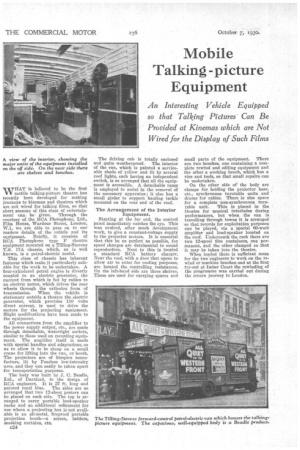Mobile Talking -picture Equipment
Page 46

If you've noticed an error in this article please click here to report it so we can fix it.
An Interesting Vehicle Equipped so that Talking Pictures. Can Be Provided at Kinemas which are Not Wired for the Display of Such Films WHAT is believed to be the first mobile talking-picture theatre has recently been developed for making journeys to kinemaa and theatres which are not wired for talking films, so that short seasons of this class of entertainment can, begiven. Through the courtesy of the RCA Photophone, Ltd., Film House, -Wardour Street, London, W.1, we are able to pass on to our readers details of the vehicle and its equipment. Briefly, it consists of RCA Photophone type b' theatre equipment mounted on a Tilling-Stevens T.S. 17A chassis, which, as is well known, is a petrol-electric model.
This class of chassis has inherent features which make it particularly suitable for the work to be undertaken. A four-cylindered petrol engine is directly coupled to an electric generator, the current from which is fed by cables to an electric motor' which drives the rear wheels through the orthodox form of transmission. When the vehicle is stationary outside a theatre the electric generator, which provides 110 volts direct current, is used to drive the motors for the projecting equipment. Slight modifications have been made to the equipment.
All connections from the amplifier to the power supply output, etc., are made through detachable, watertight sockets, similar to those used an recording equipment. The amplifier itself is made with special handles and adaptations, so as to allow it to be slung on a small crane for lifting into the van, or booth. The projectors are of Simplex manufacture, lit by Fearless low-intensity arcs, and they can easily be taken apart for transportation purposes.
The body was built by J. C. Beadle, Ltd., of Dartford, to the design of RCA engineers. It is 27 ft. long and painted royal blue. The sides are so arranged that two 12-sheet posters can be placed on each side. The top is arranged to carry portable loud-speaker racks and an additional refinement for use where a projecting box is not available is an all-metal, fireproof portable projection booth—a screen, ladders, masking curtains, etc.
024
Tho driving cab is totally enclosed and Quite weatherproof. The interior of the van, which is painted a serviceable shade of yellow and lit by several roof lights, each having an independent switch, is so arranged that all the equipment is accessible. A detachable ramp is employed to assist in the removal of the necessary apparatus ; it also has a small girder to support hauling tackle mounted on the rear end of the roof.
The Arrangement of the Interior Equipment.
Starting at the far end, the control panel immediately catches the eye. This was evolved, after much development work, to give a constant-voltage supply to the projector motors. It is essential that this be as perfect as possible, for speed changes are detrimental to sound reproduction. Next to this is located a standard RCA battery charger. Near the roof, with a door that opens to allow air to enter for cooling purposes, are located the controlling re.sistances. On the left-hand side are three shelves. These are used for carrying spares and
small parts of the equipment. There are two benches, one containing a complete rewind and editing equipment and the other a working bench, which has a vice and tools, so that small repairs can be undertaken.
On the other side of the body are clamps for holding the projector base, etc., synchronous turntable units and drums for cables. There is also space for a complete non-synchronous turn
table unit. This is placed in the theatre for musical interludes during performances, but when the van is travelling through towns it is arranged so that records for exploitation purposes can be played, via a special 60-watt amplifier and loud-speaker located on the roof. Underneath the rack there are two 12-spool film containers, one permanent, and the other clamped so that it may be taken into the theatre.
When loaded there is sufficient room for the two engineers to work on the rewind or machine benches and at the first try-out at Irober Court the rewinding of the programme was carried out during the return journey to London.












































































































